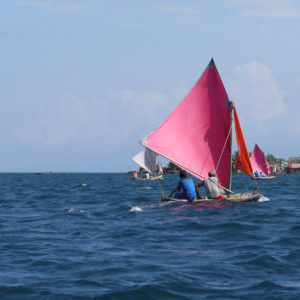From the moment I first sailed the waters of Panama’s Archipelago de San Blas in 2011, I have been fascinated by the sleek and colorful dugout canoes, called ulus, built and sailed by the Guna. At dawn’s first light, they set out from villages on small coral islands off Panama’s Caribbean coast to go to the rainforest on the mainland to farm, gather water, and get supplies for their island homes.
The Guna are indigenous Central American people who were driven from the mainland by Spanish Conquistadors, warring indigenous groups, mosquitoes, and other dangerous animals of central Panama. They have inhabited this stretch of the coast for hundreds of years and prefer to call their homeland Guna Yala, Land of the Guna—and dislike “San Blas,” the name given the islands by the Spaniards long ago.
While the islands are part of Panama’s territory, the people have political autonomy over their land, and they fiercely protect their culture by passing traditions to the next generations. The Guna have been building ulus the same way since they populated these waters, and they still rely on them for their livelihood. Kids as young as three and four years old already know how to paddle, having imitated the older kids who spend most of their time on the water, and they’ll often have child-sized rigs for practicing sailing.
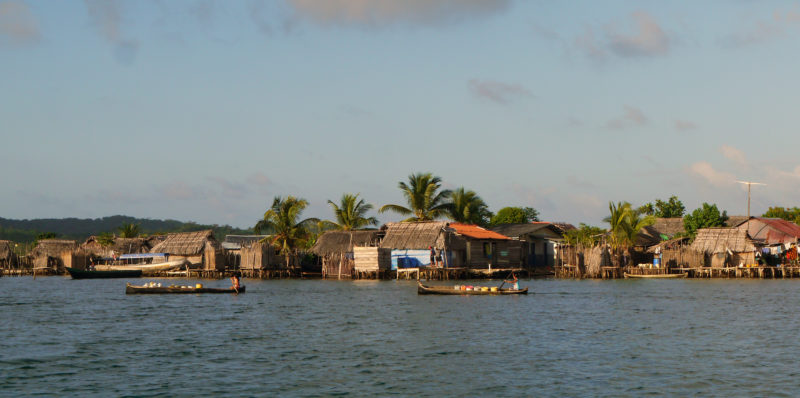 Photographs by the author
Photographs by the authorGuna women regularly paddle ulus to Rio Torti on the mainland to collect potable water from the river and gather vegetables grown in their gardens on the mainland.
Ulus are very familiar to the numerous cruisers that visit these beautiful islands. Guna villagers will often pull their ulus alongside yachts to sell lobsters, crabs, and other seafood or their finely appliquéd pictographs called molas, in exchange for things like a cold drink, the use of a hammer, or charging a cellphone.
I was working on a charter boat in Guna Yala when I had the opportunity to sail an ulu. Dino, the boat’s first mate, is a local and arranged for me to rent his cousin’s ulu for a sailing and fishing trip. Unfortunately, the wind was very light and we caught nothing on the line, but the images of that beautifully shaped and painted canoe gliding above shallow coral reefs and piercing waves were carved into my memory.
It was that same year in Guna Yala that I first met my wife, Kate. We daydreamed about getting an ulu and sailing it along the coast all the way down to Colombia, but life took another turn and we ended up in New England instead and bought TRANQUILITY, a 53-year-old 29′ fiberglass sailboat. Over the next three years we undertook a complete restoration of the boat, while also working to fund a cruising adventure. With TRANQUILITY back in voyaging mode, we started a trip south through the Bahamas and headed back to Panama and Guna Yala. I was looking forward to seeing ulus sailing again.
Ulus carry a spritsail rig. The sprit that supports the peak is a rough-hewn spar, and the mainsail is attached with a loose foot to a sprit boom then sheeted to a becket run through a hole in the sternpost. The sheet is tied with a simple knot when the helmsman is holding a steady course, but held with the free hand for frequent trimming. A small jib is set flying from the stem to the masthead. Sails are made out of just about anything on hand, from bedsheets to plastic tarps. Ulus can sail to weather with just their carved skeg under the water.
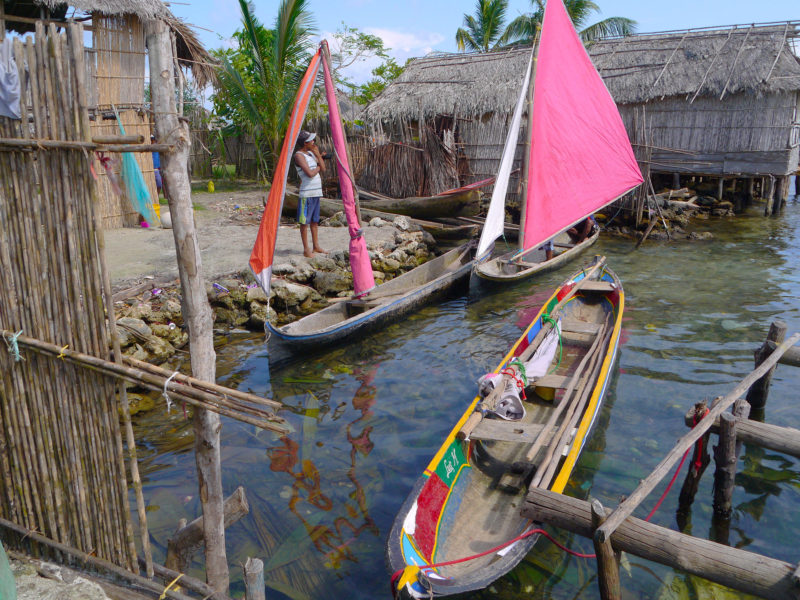
The ulus have very simple sailing rigs. Any Guna can get ready to sail in about one minute.
The Guna had never sailed for competition until visiting yachties inevitably brought their sport-sailing mentality with them, and before long, ulu races became a point of cultural exchange between transients and locals. The most recent race, which took place in January 2018, was held at Islas Robeson, a group of seven small islands tucked in the Gulf of San Blas. This westernmost archipelago is known to the Guna as Tadarguanet, “Where the sun sets.” Kate and I had never visited here, and this race was a good excuse to explore another part of Guna Yala. We approached the area after a gorgeous three-hour sail in flat seas, tacking between reefs and low-lying islands.
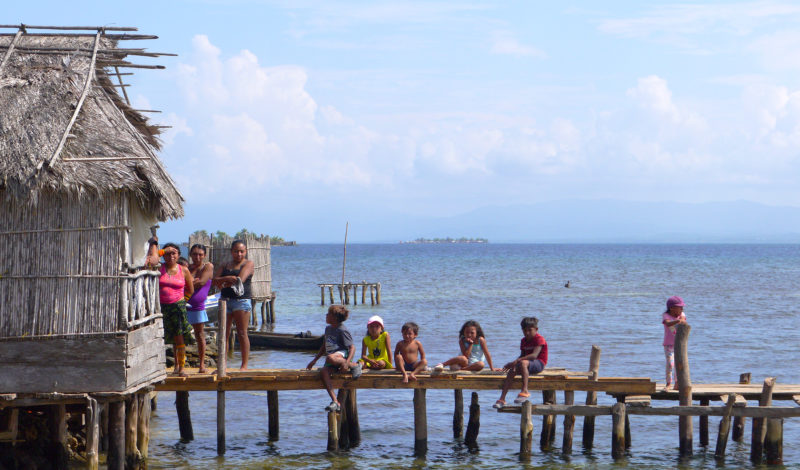
Tupsuit Dummat is fringed with wooden docks. Almost all of the structures on the inhabited islands are built of poles, bamboo, and fronds brought by ulu from the mainland.
We anchored TRANQUILITY just south of the main island, also known as Ailitupu or Isla Gerti. Like most of the inhabited islands of Guna Yala, it is close to the mainland, the source for food that grows in the forests and for fresh water from the rivers. Tupsuit Dummat is scarcely large enough to fit a football field, and the village is packed tight with low buildings and fringed with wooden docks that extend from sandy paths, backyards, and pocket gardens.
Kate and I made our way to the building that houses a school, a community center, and a store. It is the only cement structure on the island; all of the rest are made from poles and fronds gathered from the mainland forest. As small as the island is, it was easy to get lost among the finely woven bamboo fences and walls that enclose the compounds of extended families. In the center of the island is a shared kitchen where a fire is always lit. A few trees rise above the weathered thatched roofs and ajì chili peppers, hibiscus flowers and plants used in traditional medicine grow in what little open space there is.
Even with my modest 5′7″ height, I had to duck many times to avoid eaves and awnings, and to pass through tiny doors. The Guna, with an average height just under 5′, are among the shortest people on Earth, second only to the Pygmies of Africa. I felt like a giant among them.
A few older women came ahead offering molas and other handicrafts. Only Guna who had traveled to the Panamanian mainland or further for work spoke Spanish or English. Others that grew up in Guna Yala only spoke their language, which they refer to, in Spanish, as dialecto. The kids saluted each other with few words in Spanish, sometimes English that they practice in school, before continuing laughing and chatting in dialecto. Men and children wore shorts and T-shirts while women wore the traditional clothing: colorful fabric wrapped around their waists as skirts, floral blouses with mola panels sewn on front and back, and beaded bracelets that covered most of their legs and arms with geometric patterns. Some had a gold nose ring.
Back at the dock, looking across the anchorage, Kate and I admired the ulus’ rippled wakes and silent passage, allowing conversation between ulus or between the boats and land, without raised voices. While we usually saw men sailing, women go together on separate ulus to the river on the mainland to fill bottles, buckets, and jerry cans with fresh water—it was their time to be alone and have personal conversations.
Soon after settling ourselves in the anchorage and getting to know our surroundings, an ulu approached TRANQUILITY and the lone paddler introduced himself as Justino, this year’s ulu race organizer. He was wearing a baseball cap and sunglasses, and when he smiled, two gold teeth, one bearing the letter J, gleamed. Kate complimented him on the gold and he replied, “Do you like it? I have a dentist friend in Panama City. He did it for me.” He spoke a little English but switched to Spanish when he realized that we both spoke Spanish.
Justino connected us to the American owners of ALLIANCE, a beautiful steel schooner with three masts that towered above the smaller vessels in the anchorage. They were helping him put the event together by getting on the radio and inviting cruisers from the more popular areas of the archipelago. Justino was gathering donations to put together a cash prize for the race, and we were happy to contribute. After we said our goodbyes to Justino, he paddled to a neighboring cruiser in the anchorage, drumming up more support.
On the day of the race, the start was postponed a couple of times as Justino waited for more entrants to arrive and for stronger winds. It has been an unusual January; the northeasterly tradewinds that usually blow steadily during the winter season had yet to arrive. When he spotted another yacht sailing toward the islands, he delayed the start yet again, hoping the new arrivals would provide a bigger audience and more prize donations. The delay made it possible for me to help Mr. Raul, a man with small, dark eyes and fluent Spanish, who showed up at the side of TRANQUILITY paddling a ulu and carrying an inverter wrapped in a plastic bag. He politely asked if I could help fix it. It didn’t take me long to replace a fuse, crimp proper ring connectors for the battery cables, and test the inverter on TRANQUILITY’s batteries. We passed the rest of the morning translating words from Spanish to Guna to English over Italian coffee.
Raul stopped by our boat many times during our stay in the anchorage. Like him, other Tupsuit Dummat villagers introduced themselves politely before asking for favors or offering fish, yucca root, and other delicacies from their gardens. A group of kids—boys and girls from age two to age nine—showed up one day paddling an ulu. We invited them to come aboard, and after a little we realized that they intended to occupy our boat for the rest of the day. Communication was difficult because they spoke little Spanish and we spoke little of dialecto, but with a bit of patience and ample use of gestures, we started to understand each other, especially when I took out hooks and fishing lines and Kate produced paper, pencils, and crayons.
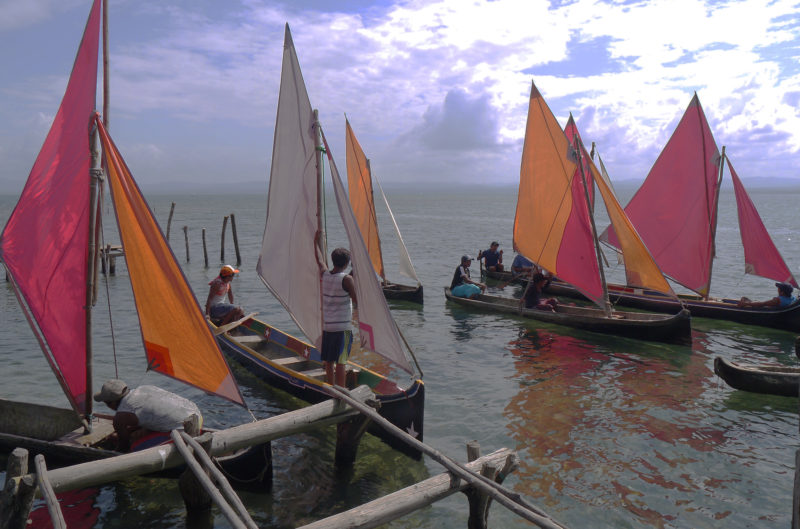
Ulu crews maneuvered in close quarters just moments before a whistle signaled the start of the race.
Finally, at 1 p.m., we all gathered at the main dock near Justino’s home. A few curious Gunas were watching the preparation, eyeing the ulus tied to the docks and the crews preparing for the race. The racing ulus that gathered for this regatta were equipped with what looked like remnants of orange and purple nylon sails from cruising yachts, recut for mainsails and jibs. After some exchanges between Justino and one of the crews in their native language, we saw them roll the mainsail and jib around the mast and quickly step a new mast with a different rig. As Justino explained, in the interest of a fair race, they were making sure everybody was using roughly the same mast and sail size. Everything else about the ulus, including their waterline length and the equipment carried on board, was hardly standard, making it a weird one-design race.
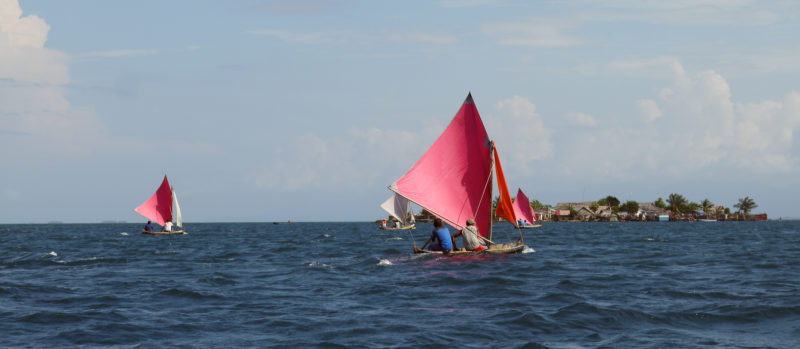
The ulu in the foreground was having trouble with its jib sheet as the fleet sailed toward Ubicandup. The rigging is often made of cheap, thin polypropylene cordage that doesn’t stand up long to the UV damage of tropical sunlight.
Justino blew a whistle, and the race was on. The ulu crews hurried to clear the docks, paddling to turn the boats, then easing the sheets to catch the tailwinds down to Ubicandup (Isla Nellie), the first marker of the course. Kate and I joined the ALLIANCE crew on their outboard-powered tender to follow the race. By the time we were all aboard and left the dock, the ulus were surprisingly far ahead of us. The shallow-draft canoes glided over coral heads and sandbanks as their crews picked the most direct course. We had to weave through unfamiliar reefs, reducing speed and lifting the outboard over obstructions. We eventually got back into the action, just in time to see the ulus go around the first marker.
Each helmsmen maneuvered using a large paddle, or cammi, and trimmed the mainsail. The single crewman aboard each ulu bailed, tended the jibsheets, and hiked out, standing on the gunwale and pulling a line tied high on the mast. At every tack, each helmsman paddled the ulus through the turns until the bow crossed the wind and settled on the new course. While the ulus were rounding the mark, the dozens of Ubicandup villagers who had gathered on the docks to watch the ulus ran the 50 yards through the village to the other side of the island to follow the beginning of the upwind leg that started as soon as the boats cleared the southern tip of the Ubicandup.
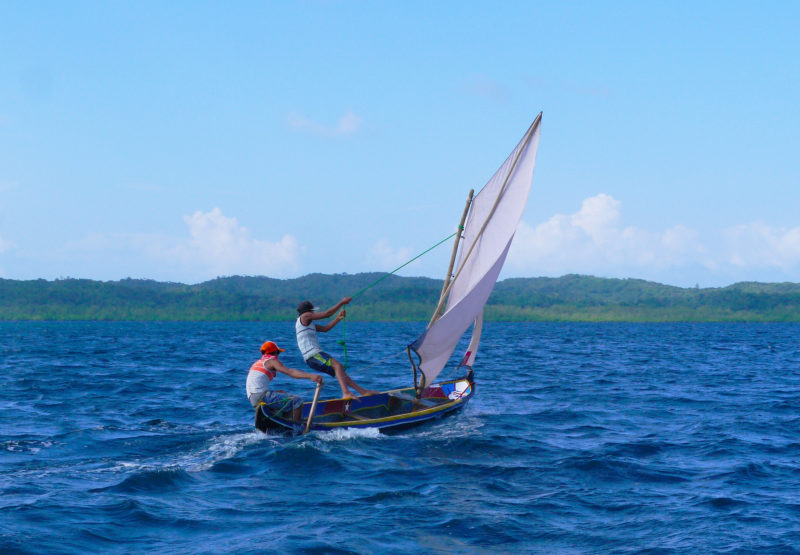
This ulu jockeyed for the lead over the first half of the race but came in second. Here they were pressing hard during the upwind leg in pursuit of the leaders.
The next marker was almost 2 miles to the northwest, back to the island of Ailitupu, which they had again to leave to port before heading for the bow of ALLIANCE, the finish line. One dugout got in trouble when they took on too much water, and the helmsman had to head into the wind while his crew bailed frantically with a small gourd bowl. Another ulu had trouble with a parted jibsheet, but was soon back in the race with the frayed ends knotted together. Another crew was wrestling with a mast that had come out of its step and was leaning precariously forward; the crewman struggled with it but was able to restep it while the mainsail was fully powered.
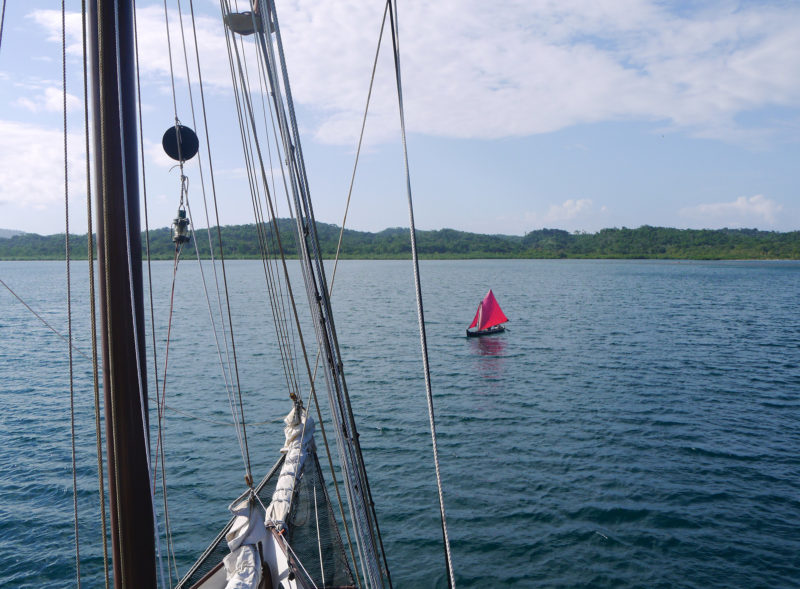
The winning crew sailed their ulu across the finish line under ALLIANCE’s bowsprit. A good two minutes passed before the second-place ulu arrived.
Eventually all the problems were resolved on the fly. All six boats came in close to Ubicandup at the turn, but then the fleet spread out on the upwind leg. The lead changed hands between the two fastest boats with almost every tack. When one ulu finally pulled well ahead, we returned to ALLIANCE to watch the finish. Only four boats completed the race, crossing in front of ALLIANCE’s bowsprit to the cheers of the spectators. Two boats never arrived, but no one was worried about them. It was, apparently, safe to assume that they had gone home as they passed close by their island, or had decided to go fishing. The official race results listed them as no aqui, not here.
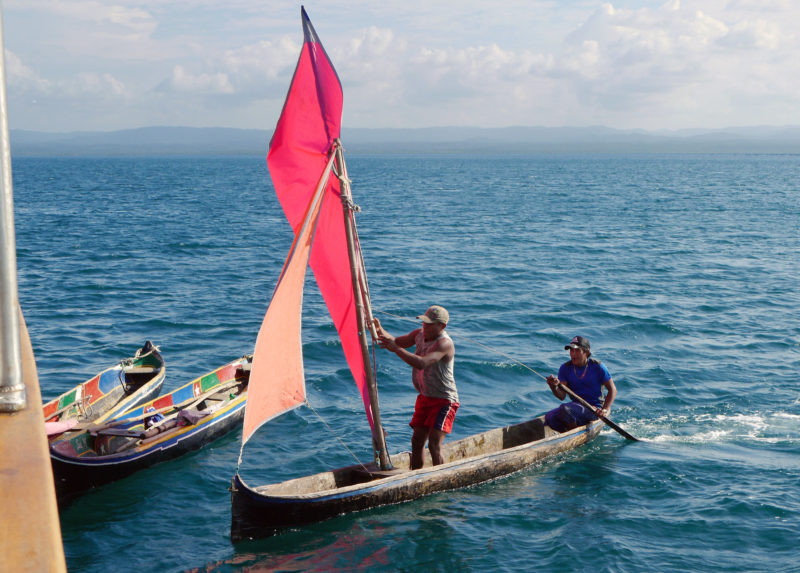
The ulu that finished in third place came alongside the two ulus that preceded it for the celebration and awards ceremony aboard ALLIANCE.
The award ceremony took place on the ample deck of the schooner, where ulu sailors and gringos shared freshly baked cookies. Justino and the owners of the schooner awarded the cash prizes, and the normally shy Guna crews seemed happy to accept the attention of the cameras.
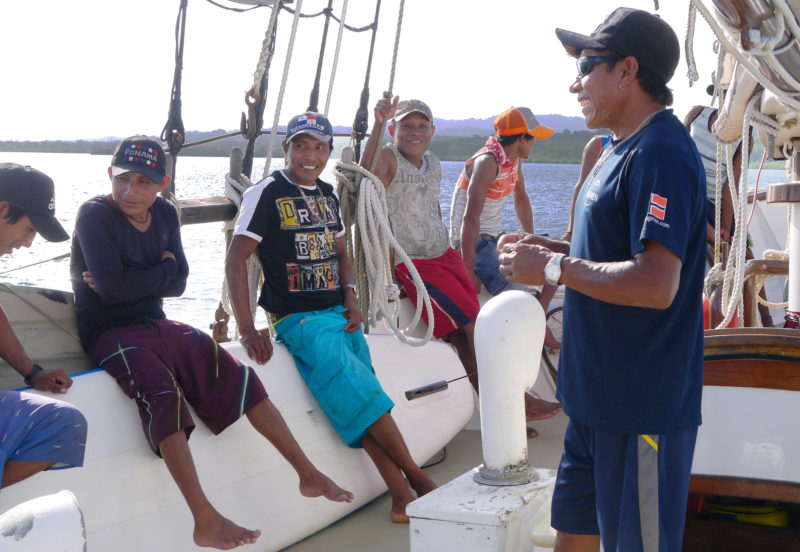
After the race Justino (right) shared a laugh with the race crews. Smiles came easily to everyone we met in Guna Yala.
That evening I helped Justino with troubleshooting his home electrical system. A 100W solar panel charges a single deep-cycle battery that powers an inverter and LED lights that hang from the crossbeams of his home’s thatched roof. Electrical power is very important for Justino—he is one of the few villagers who owns a flat-screen TV. He often invites his friends over to watch movies that he has collected on USB flash drives from cruisers who visit Guna Yala. His house has also a big gas range with an oven that his family uses to bake bread that they then sell from the window.
During the following days I toured many other Guna homes in my new role of solar-power doctor, with my waterproof bag filled with a multimeter, electrical parts, connectors, and cables. Cruisers often contribute to the locals by offering technical help and donating or swapping used gear, which can be vital for them. I was happy that my basic electrical skills were very useful to the increasingly more technological Guna.
Only in recent years have the islanders had lights on during the night. They used to go to bed very early because the nights were truly dark. They awoke at 4 a.m. without the need for an alarm clock. Solar-power equipment has been provided through a government grant for rural areas, and now the daily habits of the Guna are changing. They keep their cell phones charged, enjoy watching TV, and listen to music.
I asked Justino one day if I could see somebody building an ulu. He got back to me with Joselino, a farmer who had stopped to our boat a couple of days earlier to talk about his farm. Joselino was building a new ulu from one of the trees in his property. The best hardwood in the rainforest for ulus is mahogany, but some trees are better than others. He had found a good one, with wood that could make his ulu last for more than 20 years.
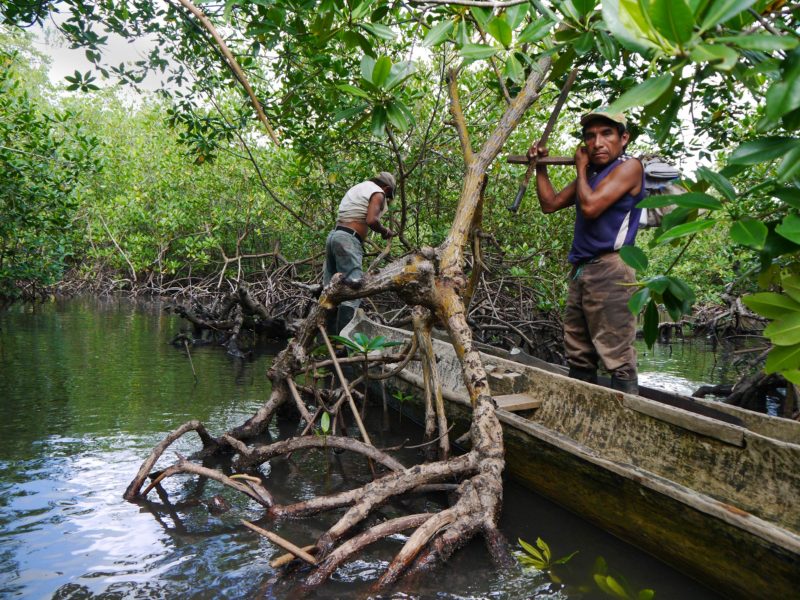
Joselino (foreground) and Justino secured their ulus to the roots of the mangroves and were ready to step ashore and walk through mud and forest trails to the building site of Joselino’s ulu.
Justino and Joselino showed up alongside TRANQUILITY one morning, each paddling an ulu, ready to take me to Joselino’s project. I followed them in my dinghy and rowed for maybe half a mile to a narrow entrance in the mangroves. We left the boats, donned rubber boots, and walked inland through the soft mud. Beyond the mangroves, the ground became more solid as we climbed steep hills of red earth through the old-growth jungle. I was not nearly as adept at making my way through the underbrush as Justino and Joselino; they were soon just two dots in the splash of green of the tropical rainforest.
They stopped to wait for me and pointed out which plants I should not touch. Among the most dangerous are palmettos with razor-blade edges, and a poisonous sort of spiny liana. Joselino balanced his axe on his shoulder; a small plastic bag hanging from it carried matches, cigarettes, and a jar of water. It was all he needed for several hours of work in the jungle. Justino did not appear to carry anything at all for himself.
More than once I felt the squishy sensation of my feet sliding in place on the wet soles of the rubber boots as I tried to keep the pace while climbing a near-vertical mud slide. My two Guna companions seemed not to know fatigue, thirst, or hunger. If they did, kept it well hidden. At every stretch of the trail, Joselino would point out the expanse of his property, and how he was planning to grow bananas on one side of the path, yucca and plantain on the other, but he was, unfortunately, too busy to do it himself. Imagining the amount of work, done without the aid of animals or machines in that harsh environment, made me think how impossible the task seemed, but the Guna have been doing this type of work for centuries.
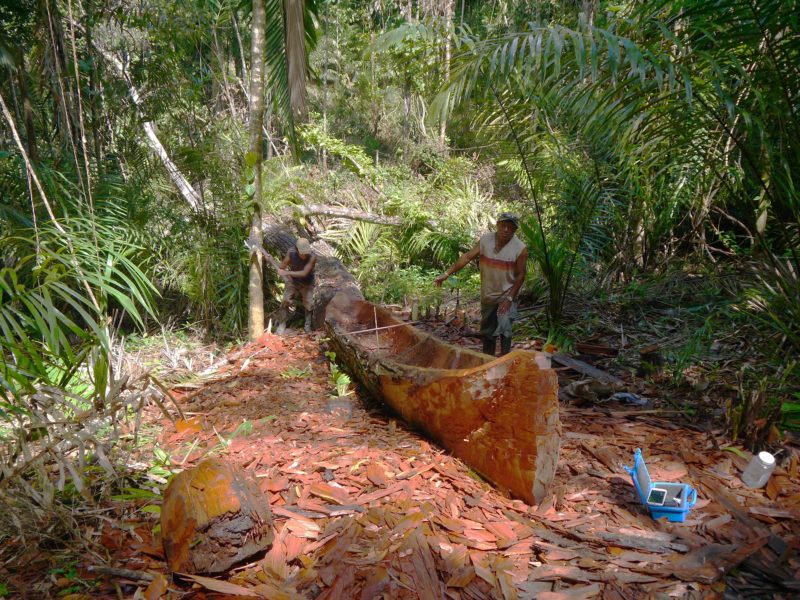
Joselino worked the sides of the canoe with his ax. He could build an impressive vessel from a tree trunk using only very simple tools.
After walking for 40 minutes, we reached the tree that Joselino had felled. He had already spent three long months alone working it with his axe. The rough shape of a canoe had emerged, surrounded by mahogany wood chips. Joselino immediately got to work carving out the interior of the hull. His skill quickly became evident when I took a turn at the axe, and was quickly embarrassed by my clumsiness, although my guides were happy to see me eager to try. “Now you know more than most of the Guna!” they told me.
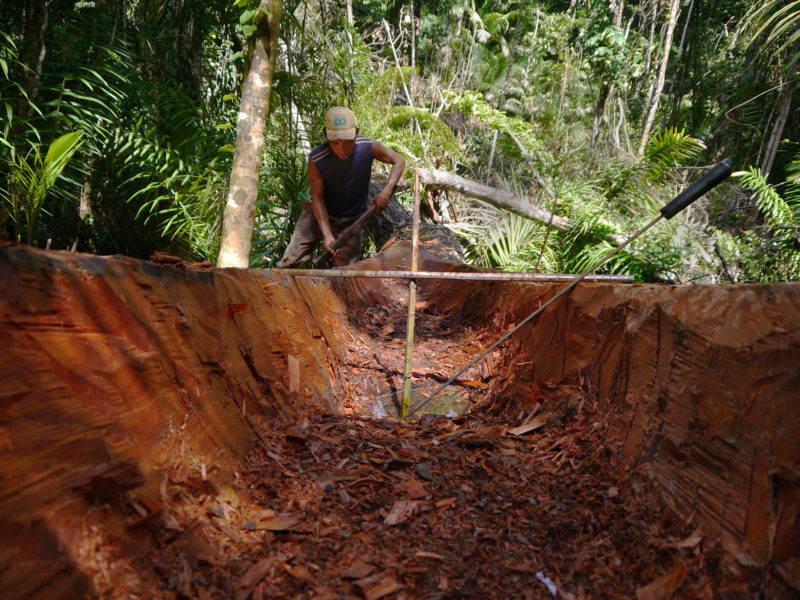
The log was already well on its way to becoming a canoe, but there was still a lot of wood to carve before it reached a good balance of strength and an easily managed weight.
Joselino would work in the forest until the ulu is close to its final shape and light enough to be carried by a party of people through the jungle all the way to the water. He was already planning to open another trail for that purpose, longer than the one we had hiked, but with a gentler grade to facilitate carrying the heavy canoe down to the water. He would have to ask for the help of his fellow islanders that day, favors that he would have to repay someday either with cash or with labor. They said that the day the ulu would be brought from the land to the ocean there would be a big party, almost like a celebration for the birth of a child.
Once the ulu reaches the island, it will be kept in the water for few days to get rid of insects and pests, then pulled out to dry for the final finishing and painting. Joselino promised me that we would go sailing and fishing on his ulu on my next visit to the islands. During our stay in Guna Yala, Kate and I were captivated by the tranquil atmosphere of the islands and the generosity of the people we met. We prepared to leave and sail TRANQUILITY up the coast to Costa Arriba for some maintenance, happy to have had the chance to witness such special events involving beautiful sailing craft and their amazing crews.![]()
Fabio is currently in Panama with Kate, living aboard their Columbia 29. They are getting ready for longer sailing routes in the Pacific. For Fabio, boats are both a professional career and a passion, a form of expression and a means to explore wonderful habitats.
If you have an interesting story to tell about your adventures with a small boat, please email us a brief outline and a few photos.
